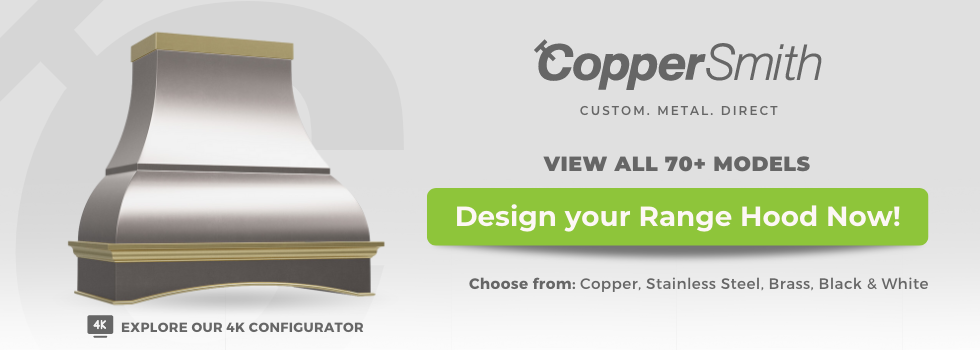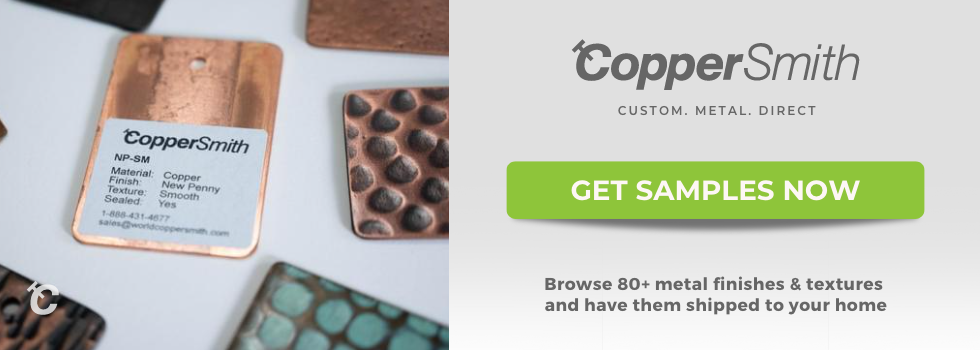Range hoods are used to vent bad odor away from your kitchens during and after cooking. Whether you own a small kitchen space in your home or need to pull odors away from your commercial establishment, it’s important to install a good working range hood. However, most people don’t realize that residential and commercial range hoods are different from each other. CopperSmith specializes in Quality Copper Range Hoods but there are many choices.
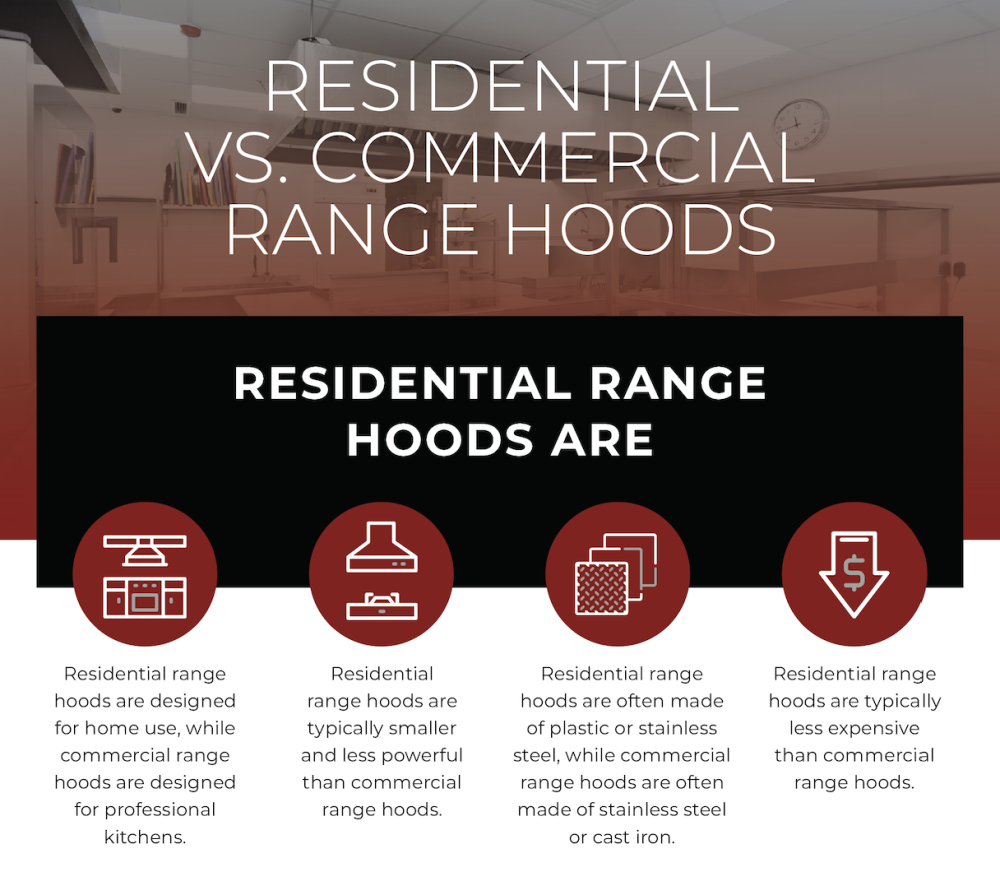
Can I Use a Commercial Range Hood in My Home?
The right commercial range hood can provide you with an amazing product that suits your kitchen’s style and aesthetic seamlessly, but the wrong type can cause the opposite effect. The right commercial range produces the capability to create amazing dishes, while also enhancing the cooking experience, but there are a number of factors to consider if you think your home would benefit from a commercial hood, including:
Your Electric and Gas Capabilities
Commercial ranges can use both electricity and gas. Commercial settings tend to be fitted with the proper gas and electricity connections, while standard residential homes are not usually pre-equipped to deal with a commercial range hood. Residential ranges are usually designed to accommodate in-home cooking rather than mass-producing food for large amounts of people.
The Cooking Environment
There is a big difference between a commercial and residential cooking environment. A commercial range will need a high-powered ventilation system to guarantee a safe cooking environment. The ventilation or hood in a residential cooker is lower power than a commercial range, but a standard residential kitchen usually has the implements to facilitate this. Commercial environments have a lot more rules and regulations because of the higher potential for dispersing particles such as grease into the air.
Cost
The cost does not purely relate to the range hood itself, but a commercial or residential setting will have a number of differences that can affect the final bill. Electricity and gas bills can increase with a commercial range hood because of its need for higher output. Many manufacturers are moving to more energy-conscious commercial designs, but as residential ranges are usually manufactured to provide capabilities in an energy-conscious way, generally with reduced costs, this can be a more suitable option for residential properties. Additionally, there are costs such as the day-to-day running of the equipment and the insurance. A commercial company will have different costs and standards set by the insurance company, and a homeowner using a residential range does not need to take this into account.
The Need for Alternative Equipment
In a residential setting, there is a reduced need to use a commercial range because a standard kitchen does not necessarily require additional equipment, for example, countertop convection ovens or griddles. Of course, many people have grand ambitions of doing lots of barbecues with their residential range cookers, but the reality is that it is easy enough to create food for a number of guests. In a commercial setting, the volume of people who are looking for food increases, and therefore, a commercial range cooker becomes a more essential component.
Lots of people may think about having a commercial cooker installed in a residential setting, but the fact is you need to have the appropriate environment that will facilitate its use. A commercial range could be a successful fit for you, but you should consider all of these components and if the commercial range is going to benefit you. Lots of people are attempting to work out of their homes, but the reality is that for most people, a residential range hood is more than adequate.
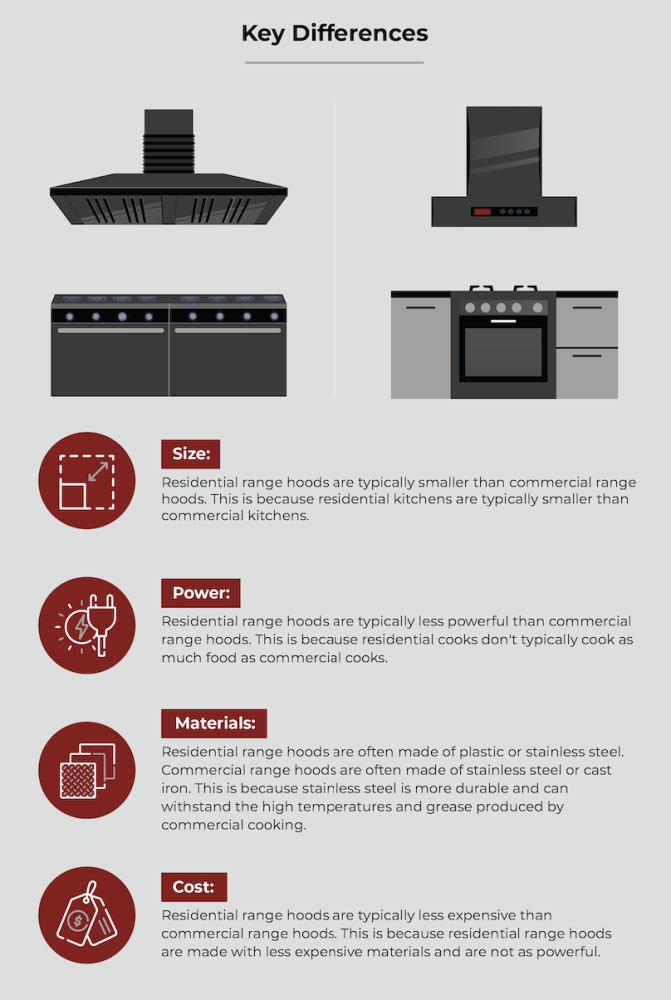
Kitchen Range Hoods
While both commercial and residential gas hoods are available in different sizes and styles, commercial ranges are manufactured from heavier materials. This makes commercial range hoods more durable than standard residential ranges. It’s worth mentioning that commercial gas ranges also generate way more cooking power. They are also larger, and lead to more cooking capacity.
In order to make the best choice when choosing gas hoods, you need to consider some important factors. Below are helpful aspects so that you make an informed choice:
Weight is a Factor
Since commercial vent hoods are heavier, they require buttressing or reinforcing the floor. This makes sure the floor is able to take their weight and does not cause any major problems. It’s important to consider the weight of the equipment.
Building Codes
This is perhaps one of the most important differences in residential and commercial gas ranges. When you want to install a commercial range hood, you need to comply with local building codes. Regardless of where you install it, you will have to comply with all the regulations in your area. It’s important to check with reputed vendors in your area and gather more information. You can also check for this information on the Internet.
Exhaust Hoods
As mentioned earlier, a residential gas range produces lower cooking temperature. Therefore, it does not require a high end exhaust hood. On the other hand, a commercial gas range needs a range hood that matches the capacity of the stove. The commercial vent hood is important to keep your kitchen safe. It effectively vents out combustion gases out of your kitchen. In most cases, homeowners install basic hoods to vent gases and odors.
Safety Measures
Commercial range hoods come with a lot of safety measures. These equipment have lights that turn on and off according to the level of combustion in the kitchen. Some high end range hoods also have advanced safety features, and different speed settings.
Appearance
It’s important to understand that commercial style range hoods are aesthetically more appealing. They have a very commercial look. As mentioned earlier, they are heavier than residential range hoods, but generate way more power. They are necessary in every commercial establishment to make sure the staff members and customers don’t experience any problems regarding bad odor and combustion gases.
Ventilation
Residential range hoods typically have one of two ventilation options: ducted or ductless. Ducted range hoods remove contaminated air through an external vent, offering better ventilation, while ductless range hoods simply filter and recirculate the air.
If you’re remodeling your kitchen or building a new home, then a ducted range hood is usually the better option. Not only will it filter grease out of the air, but it can reduce the build-up of cooking odors, and draw more heat outside, making your kitchen more pleasant to cook in.
But since ducted range hoods require access to the exterior of your building, they may not be an option for all kitchens, especially if you live in an apartment building or don’t want to rearrange your kitchen to accommodate a new ventilation system. The most important part of ventilation is the capture area, and getting the ideal range hood depth.
Let’s take a closer look at the three main installation options for residential range hoods:
Recirculating
As mentioned, ductless range hoods don’t need a connection to the open air, so they’re essentially a self-contained unit. You can install a ductless range hood pretty much anywhere in the kitchen, and even tuck it away in an overhead cabinet.
These units filter and recirculate the air, usually with an aluminum mesh filter, providing protection from airborne grease and particulate matter. Recirculating range hoods are a budget-friendly option, but they aren’t as effective as ducted range hoods.
Their main downsides are that they can be noisy when the fan is running, they don’t pull odors and heat out of the kitchen, and their filters need to be cleaned once per month to be effective.
Roof cap vs. side cap
If you’re installing a ducted range hood, then you have two main ventilation options, both of which require fans to push the air through the ductwork and outside of the house.
A roof cap allows the air to escape through the roof, which may mean it’s carried a shorter distance from your kitchen to the exterior. A side cap wall duct typically carries the air horizontally along a truss and releases the air below the roof at a downward angle.
Whichever type of cap you use, you’ll need a backdraft damper to keep any air and moisture from entering the duct from outside the house.
Additional Options
Modern range hoods are becoming more and more complex, and these days, you can find features that didn’t even exist a few years ago. While lighting comes standard with most range hoods, you can also find range hoods with heat sensors, electronic controls, and even WiFi connectivity!
Many homeowners are drawn to the idea of a gourmet “chef’s kitchen”, and want to include all of the tools that you would find in a commercial kitchen.
But many of these range hood features are also available on residential range hoods designed for home use. Let’s look at some of the latest options you can install at home:
Lighting
First, why is lighting so important? Second only to ventilation, this may be the most useful safety feature that range hoods bring to your kitchen. Lighting enables you to keep an eye on everything going on in your kitchen, even if the stove is tucked away in the corner of the room.
The best range hoods come with multiple lighting options, so you use the appropriate light for any time of day and reduce glare and shadows in the kitchen.
Depending on the fixture, you can use flourescent, incandescent, halogen, and even LED bulbs, but keep in mind that the bottom of your range hood can reach high temperatures and isn’t suitable for most of the LED bulbs on the market. You’ll need to purchase specialty LED bulbs for it.
Electronic controls and sensors
Some hi-tech range hoods have more than just an on/off switch. Electronic controls allow you to choose exactly the right setting for any situation. Keep the fan on in the background for low-heat recipes, and turn it up higher when you have all the burners running.
Other options include heat sensors that can automatically increase the airflow when necessary, and timers that turn off the fan after a set amount of time. That way, you leave the fan on while sitting down for dinner, without having to worry about turning it off later.
Less common, but still worth considering, are height-adjustable range hoods that can be raised and lowered with a motor to adapt to the cook’s height or its placement in the kitchen.
For example, some island range hoods can be raised up toward the ceiling when not in use, while downdraft range hoods feature panels that retract into the wall or island.
In short, while installing a commercial range hood in your home may be tempting, there really isn’t any need to. Residential range hoods are advanced enough to meet all of your home cooking needs, and are more suited to the dimensions and limitations of a home kitchen.
If you’re running a restaurant or a catering business, though, a residential range hood may not cut it. You’ll need the extra power of a commercial range hood to handle the demands of your kitchen.
When it comes to opting for a residential or commercial range hood, both can provide amazing benefits, as long as they are used in the right setting. There are so many differences between a commercial and residential range hood, not just in terms of the equipment itself, but it can have a great impact on the overall cooking experience, which is why we are striving to make things easier for you by providing tools to ensure you make the best decision.
Because commercial and residential range hoods provide a number of different benefits, you need to be sure that you are making the right choice. This is why we have created a tool that ensures you can customize the ideal commercial or residential hood for your specific needs. From the finish to the texture, the crown, the strap, rivet, mount, as well as the height, width, and free samples, we can ensure that you have a complete CAD 3-D rendering and quote within the space of 24 hours.
Choosing the right type of cooker should be an enjoyable experience, and if you are looking for a commercial or residential range hood that is built to last and will ensure you get everything you need out of it, you can get in contact with us for a quote that will give you the best solutions going forward.
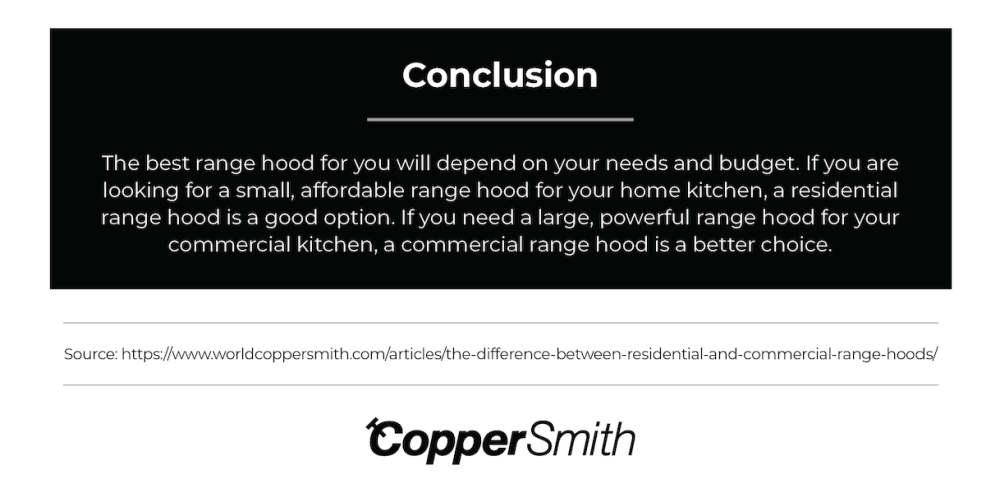
Quality Range Hoods
These days, commercial range hoods can be easily bought online. There are many vendors who have their own websites. You can check the product catalog, and find a range hood suitable for your establishment. However, you should consider all the factors discussed in this post to make the best choice. You need to look for an experienced vendor offering products at affordable prices.
Contact CopperSmith online, by phone at 888-431-4677 at or shop copper range hoods online for a quality kitchen product today!





